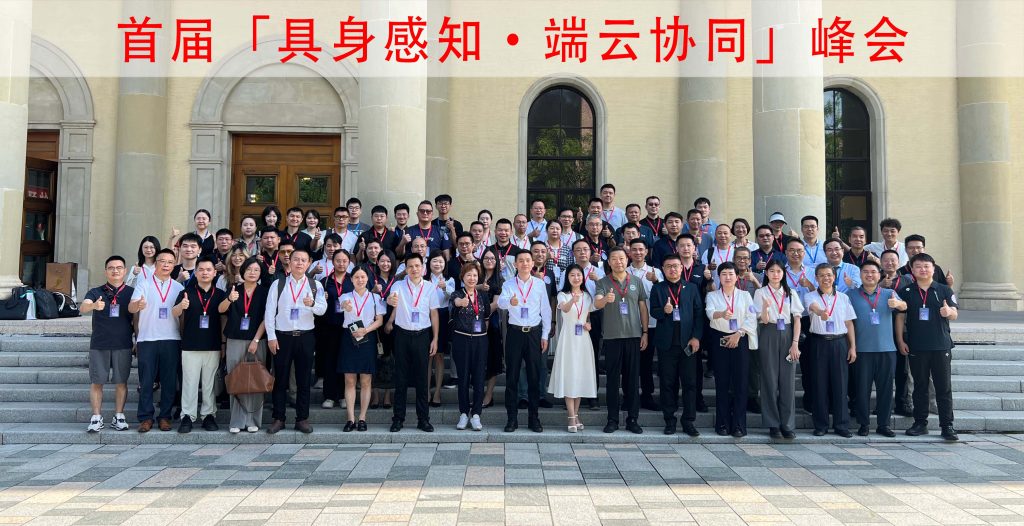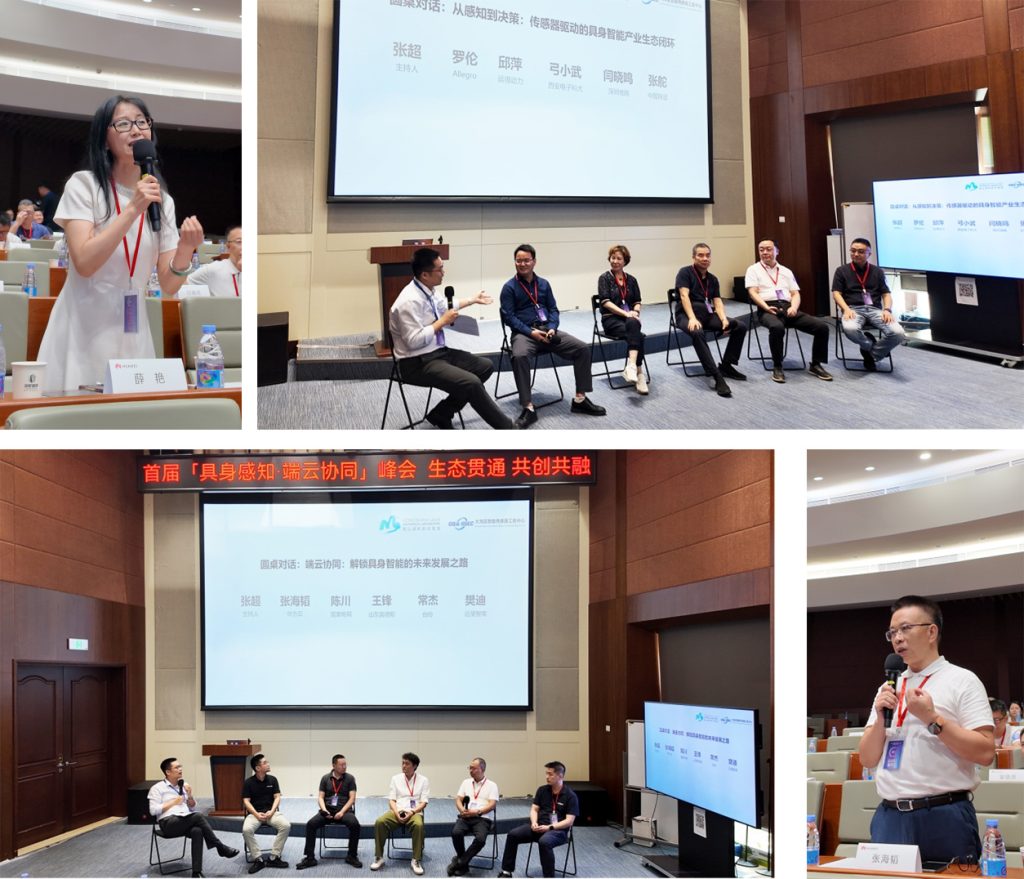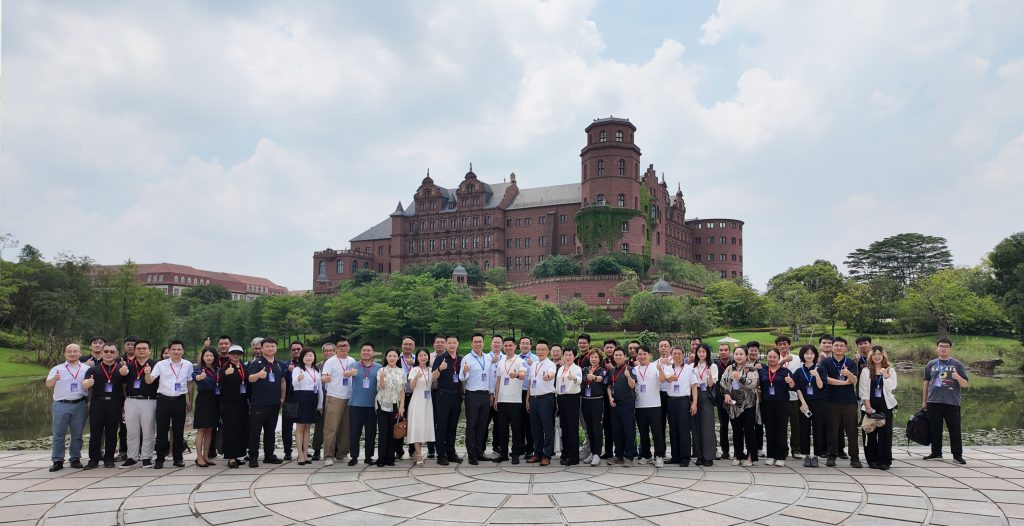On August 8, 2025, the inaugural “Embodied Perception · Edge-Cloud Collaboration” Summit, guided by the Dongguan Municipal Bureau of Science and Technology,Songshan Lake Technology Innovation Bureau, and Songshan Lake Industry and Information Technology Bureau , and jointly organized by the Greater Bay Area Intelligent Sensor Engineering Center of the Songshan Lake Materials Laboratory, Huawei Cloud Computing Technologies Co., Ltd., EqualOcean Intelligence, and Techxcope Think Tank, was successfully held at Huawei’s Ox Horn Village. Experts and scholars in the fields of intelligent sensors and embodied intelligence, along with corporate representative across the country, gathered to focus on the innovative applications and strategic development of embodied intelligent perception technology and robotics across various industries. Hua Xia Bank Co., Ltd. Dongguan Branch was specially invited as the financial partner to provide financial support for industry development. Centered on three major themes—Huawei’s CloudRobo Technology Foundation & Embodied Intelligent Ecosystem Construction, Industry Development & Frontier Insights, and Scenario Practices & Collaborative Evolution—the conference featured eleven thematic reports and two rounds of panel discussions, deeply exploring the application and development direction of intelligent sensor technology in the embodied intelligence field.

Feng Ji, Party Secretary and Deputy Director of the Songshan Lake Materials Laboratory, in his opening speech, introduced how the laboratory leverages its research foundations in sensing functional materials, new semiconductor technologies, and high-strength lightweight materials to support the technological innovation and industrial implementation of embodied intelligence. He stated that the summit aims to build consensus, inspire ideas, promote the deep integration of material R&D with embodied intelligence, and inject new vitality into the collaborative evolution of the industry.
Zhang Chao, Executive Director of the Greater Bay Area Intelligent Sensor Engineering Center, presented a report titled “From Perception to Action: AI Sensor Empowers the Collaboration and Practice of the Embodied Intelligence Ecosystem”. He introduced the center’s work, proposing an AI sensor-driven embodied intelligence innovation ecosystem and emphasizing the importance of a market-driven co-creation model for industrial innovation. He explained that the center will leverage the scientific research resources of the Songshan Lake Materials Laboratory and the supply chain advantages of the Greater Bay Area to build a comprehensive industrial ecosystem aggregation platform targeting key components such as core sensors, robot bodies, model training, and embodied testing.

Frontier Reports:
Technology Foundation & Ecosystem Construction
Yang Nan, Senior Technical Expert at Huawei Cloud EI, in his report “CloudRobo Embodied Intelligence Platform: Leading Robot Industry Innovation”, focused on introducing CloudRobo’s design philosophy and its rich toolchain for a one-stop development platform, including embodied training, embodied planning, and embodied execution models. This platform helps embodied intelligence enterprises rapidly achieve model training and commercial application implementation, effectively addressing challenges such as cloud-edge interconnection standards, model training, and generalization.
Loren Luo, Senior Manager of Strategic Business Development at Allegro MicroSystems, in his presentation “Allegro Provides Compact and Precise Robot Design”, shared how chip-level solutions for magnetic sensors, power devices, and drive & control systems in embodied intelligence empower embodied intelligent product design, along with application cases in automotive, industrial, and consumer fields.
Professor Wang Yu, Dean of the School of Advanced Engineering at the Greater Bay Area University and Chief Scientist of Daimon Robotics, in his speech “Embodied Skills: Skillful and Dexterous”, explored how visual-tactile perception and manipulation technologies empower the intelligent manufacturing industry. He shared insights on optical-based tactile sensors and their perception algorithms. Combining the intelligent generalization capabilities of a universal dexterous end-effector and an embodied intelligent cerebellum, he introduced practical application cases in factory automation.

Frontier Reports:
Industry Resonance & Frontier Insights
Wang Bin, Chairman of EqualOcean, in his presentation “Development of China’s Embodied Intelligence Industry and Sensor Research Insights”, shared the latest opportunities and challenges in the humanoid robot industry. While industrial capital enthusiasm in the embodied intelligence field continues to rise, technological bottlenecks and mass production costs remain core challenges. He noted that autonomous driving experience provides a progressive development path for embodied intelligence—from layered algorithms to end-to-end intelligence. Combined with multimodal interaction and adaptive learning, this will reshape the landscape of embodied intelligence markets such as manufacturing, healthcare, and home services in the future
Zhang Haitao, HarmonyOS Senior Technical Expert at Huawei Cloud Developer Village, in his report “HarmonyOS: The Neural Center for Embodied Intelligence Evolution”, introduced HarmonyOS’s microkernel-based distributed architecture. HarmonyOS’s distributed soft bus technology enables multi-device networking and omnidirectional perception, and its low-latency characteristics are highly suitable for the needs of the embodied intelligence industry. Using Huawei’s embodied robot developed based on the HarmonyOS architecture as an example, he demonstrated the application potential of the HarmonyOS system. The HarmonyOS ecosystem will continue to drive innovation in the embodied intelligence field.
Wu Che, Chief AI Strategy Officer of Xinfengwei, in his talk “Winning the Future with Intelligence: AI Empowers High-Quality Enterprise Development”, shared practical paths for enterprise digital transformation. He emphasized that AI empowerment for enterprises is not a multiple-choice question but a survival imperative. As AI deeply integrates with enterprise R&D and management, it will bring significant management benefits to enterprises in industries like embodied intelligence. There is an urgent need to reconstruct competitiveness based on the integration of AI and enterprise management, adopting a trinity approach of “Strategy-Skills-Processes”.

Frontier Reports:
Scenario Practices & Collaborative Evolution
Chen Chuan, Senior Engineer at the China Electric Power Research Institute (CEPRI), in his report “Strategic High-Value Application Scenarios for Embodied Intelligence in the Power Industry”, focused on the pain points of intelligent upgrades in power systems. He introduced the embodied intelligence requirements for scenarios in smart grids, such as handling high-risk operations, complex environments, and equipment defect detection. He pointed out that building a “perception-action closed loop” can effectively reduce human risks and promote the transformation of power equipment maintenance from “scheduled maintenance” to “condition-based early warning.
Chang Jie, Vice President of Tailg Group, in his presentation “Embodied Intelligent Care Robots”, introduced Tailg’s innovative practices focusing on intelligent robots in the health care field. Chang Jie noted that the rapid development of artificial intelligence, especially generative AI, provides the core driving force for the industry. Tailg is committed to creating intelligent companion robots to build a new low-carbon travel ecosystem suitable for the elderly.
Gao Yongguang, Founder of Beizhi Technology, presented “Indoor Scene Agents and Robot Solutions”, introducing an indoor scene embodied agent technology architecture tailored to the needs of fine-grained asset management in commercial and home environments. By reconstructing physical space interaction methods through multimodal perception and autonomous decision-making technologies, the company promotes the application of indoor scene robots in fields such as power grids, hospitals, and schools.

At the meeting, Liu Qiang, General Manager of the Corporate Business Department of Hua Xia Bank Guangzhou Branch, introduced the bank’s specific plan as financial capital to support the innovative development of the embodied intelligence industry.

Panel Forums
The summit featured two in-depth panel discussions, hosted by Zhang Chao, Director of the Greater Bay Area Intelligent Sensor Engineering Center.
During the panel discussion “From Sensing to Decision-Making: Sensor-Driven Closed Loop of the Embodied Intelligence Industry Ecosystem”, experts from institutions including Allegro,Dynamic Wintec, Xidian University, Shenzhen Metro, and China Railway Design Group engaged in lively discussions on topics such as intelligent power systems and AI applications, smart workshop construction and robotics technology innovation, sensing and power drive technologies, as well as the challenges and opportunities of sensing and intelligent application scenarios in urban infrastructure management and maintenance.
In the panel discussion “Edge-Cloud Collaboration: Unlocking the Future Development Path of Embodied Intelligence”, experts from institutions including Huawei Cloud, Tailg Technology, State Grid Corporation of China, Shandong Aodes, and Techxcope Think Tank conducted in-depth discussions focusing on the technical advantages of edge-cloud collaboration and the HarmonyOS system, prospects for embodied intelligence empowering daily life, technology innovation cooperation driven by State Grid’s demand, and civil-military integration industry collaboration, all contextualized within edge-cloud collaborative applications.

This summit established a deep exchange platform for industry, academia, research, and application within the embodied intelligence field, effectively promoting collaborative innovation across the industry chain’s upstream and downstream. All participating parties will further accelerate breakthroughs in embodied intelligence-related technologies and industrial implementation, serving the technological innovation of the Greater Bay Area, through jointly building hardware and software platforms for embodied intelligence ontology, data, and models in the region.

